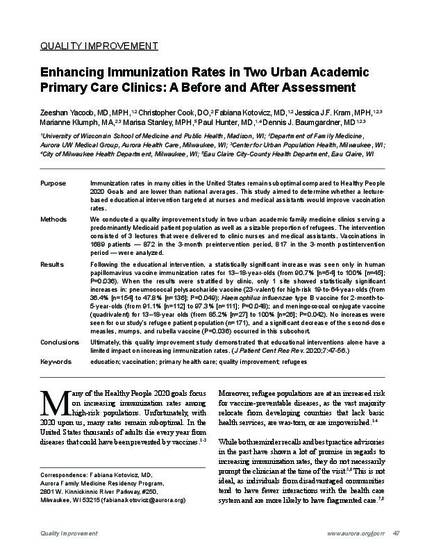
- education,
- vaccination,
- primary health care,
- quality improvement,
- refugees
Purpose: Immunization rates in many cities in the United States remain suboptimal compared to Healthy People 2020 Goals and are lower than national averages. This study aimed to determine whether a lecture-based educational intervention targeted at nurses and medical assistants would improve vaccination rates.
Methods: We conducted a quality improvement study in two urban academic family medicine clinics serving a predominantly Medicaid patient population as well as a sizable proportion of refugees. The intervention consisted of 3 lectures that were delivered to clinic nurses and medical assistants. Vaccinations in 1689 patients — 872 in the 3-month preintervention period, 817 in the 3-month postintervention period — were analyzed.
Results: Following the educational intervention, a statistically significant increase was seen only in human papillomavirus vaccine immunization rates for 13–18-year-olds (from 90.7% [n = 54] to 100% [n = 45]; P = 0.036). When the results were stratified by clinic, only 1 site showed statistically significant increases in: pneumococcal polysaccharide vaccine (23-valent) for high-risk 19-to-64-year-olds (from 36.4% [n = 154] to 47.8% [n = 136]; P = 0.049); Haemophilus influenzae type B vaccine for 2-month-to-5-year-olds (from 91.1% [n = 112] to 97.3% [n = 111]; P = 0.048); and meningococcal conjugate vaccine (quadrivalent) for 13–18-year olds (from 85.2% [n = 27] to 100% [n = 26]; P = 0.042). No increases were seen for our study’s refugee patient population (n = 171), and a significant decrease of the second-dose measles, mumps, and rubella vaccine (P = 0.036) occurred in this subcohort.
Conclusions: Ultimately, this quality improvement study demonstrated that educational interventions alone have a limited impact on increasing immunization rates.
Yacoob Z, Cook C, Kotovicz F, Kram JJ, Klumph M, Stanley M, Hunter P, Baumgardner DJ. Enhancing immunization rates in two urban academic primary care clinics: a before and after assessment. J Patient Cent Res Rev. 2020;7:47-56. doi: 10.17294/2330-0698.1709
